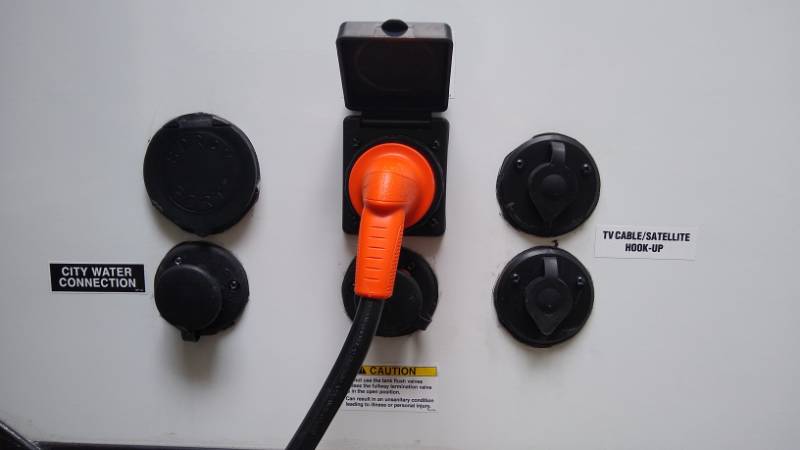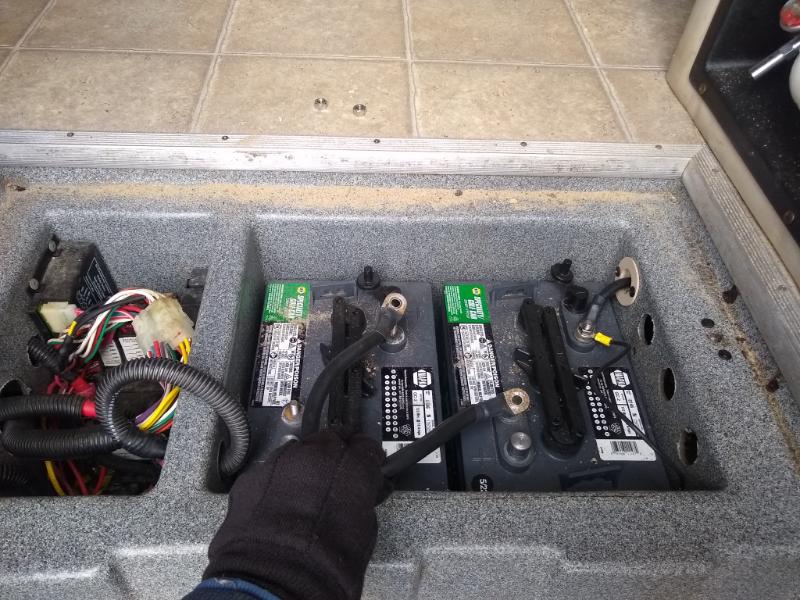If you’re new to RV camping, you might be wondering how your RV battery gets recharged. Does the battery get charged when you’re hooked up to shore power, for instance?
Psst … if you’re not familiar with the term “shore power,” we have a lot to talk about! But before I drench you with science, let’s sip from the soft stuff.
PUBLIC SERVICE ANNOUCEMENT! Unfortunately, the internet knows this is a question often posed by new, defenseless, babes-lost-in-the-woods RV owners. A lot of the information out there is bogus. I read one article that suggested your house batteries were only being trickle-charged while plugged in, which is absolutely false. Another article said the batteries were charged at a constant current, which is also untrue (unless they’re lithium) .… And yet another article said batteries were 80% charged at 10.5 volts, which is laughable. At 10.5 volts, your 12-volt battery is beyond dead! So don’t trust everything you read out there, ok?
Is an RV Battery Charged When Plugged In to Shore Power?

Short answer: Yes, your RV charges your house battery bank when you’re plugged in. Your onboard batteries are recharged by the converter, which is kind of like a fancy battery charger. This allows your battery and converter to work in tandem to supply 12-volt DC power to your RV’s low-voltage electrical loads.
Should I Disconnect My Battery When I’m Plugged In?
The converter-battery charging process is automatic, safe and normal. There is no need to disconnect your house battery while plugged in during camping. In fact, disconnecting the battery will usually harm more than help your RV, because you’ll force the converter to do all the hard work alone.
>>> Read More: No, You Shouldn’t Disconnect Your RV When Plugged Into Shore Power
The same advice applies to if you’re plugged into a generator (whether portable or onboard), or whether you’re running off solar power. There is no need to disconnect the battery, except in the rare case where you have a single-stage converter and flooded lead-acid batteries.
If you have a single-stage converter, which were commonly installed in RVs under the mid 2010’s, you could “boil” your battery if you leave it plugged in for too long. This is not really a problem for weekend camping, especially if you double-checked the battery’s electrolyte levels beforehand.
To be honest, if you’re still rockin’ a single-stage charger, I’d chuck that thing in the trash and buy a real 3-stage modern converter. You’ll save yourself a major headache.
What’s the Difference Between a Coach and a Chassis Battery?
ALERT! It’s worth reiterating that we’re talking about your “house” batteries, also known as your “coach” batteries. These batteries are used to run the DC-powered loads in your camper, such as your ceiling lights, fans, and water pump.
Common locations for house batteries include:
- Travel trailer: on the tongue
- 5th wheel: in the front cargo bay
- Motorhome: under the entry step or in the basement, behind the axles
- Van: Buried in the cabinetry at floor-level

These are NOT the same as your “chassis” or “starter” batteries, which are only used in motorhomes and vans to start the engine. Plugging into shore power does NOT charge your starter batteries unless your motorhome is equipped with a Battery Isolation Manager (BIM) capable of monitoring system voltages. But again, that’s beyond our scope.
Ummm … I Have a Battery? What’s a Converter Do?
If I’ve just been confusing you with all my lingo like “converters” and “DC electricity,” then you should start with my RV 101 Electrical guide. Here’s a quick excerpt from that post about the RV 12-volt DC electrical system:
The low-voltage side of your RV’s electrical system is used for low-power electrical loads, like ceiling lights, the water pump, the furnace fan, and most appliance controls.
If everything in your RV ran off 120VAC electricity, you wouldn’t be able to do anything without being plugged in! 12V electricity makes dry camping and traveling much, much easier (and safer). For this reason, electric and slide-out leveling motors often also run off 12 volts, not because they are small loads, but because they can be operated without being plugged in.
Your RV has one or more house batteries that make up the main battery bank. If you have a motorhome, you also have a starter battery for your engine, but the two battery systems are normally not connected (unless equipped with a battery isolation/management system. See the Intellitec BIRD relay as an example.)
These house batteries provide 12-volt power directly to your low-voltage loads. They are wired to a fuse panel, which is connected to individual DC circuits.
There is usually a battery cut-off switch and battery protection “shortstop” fuse between the fuse panel and the battery bank. You should learn where this switch and fuse are located.
Most appliances, even the “120-volt” ones like air conditioners, typically use 12-volts to run the control boards! You can think of the 120VAC electricity as the “brawn” and the 12VDC electricity as the “brain.”
***
You might be thinking, “If my RV has a battery, don’t batteries need to be recharged? How does that happen?”
Great question! Almost all campers and motorhomes have a built-in battery charger called a converter. A converter then transforms some of the 120-volt AC electricity to 12-volt DC electricity.
A converter is commonly called the “heart” of your RV’s electrical system. It actually does more than just charge your battery. When you’re plugged into shore power, the converter directly powers all of the low-voltage loads. It’s a hardworkin’ device. Most batteries aren’t strong enough to power your RV’s DC loads without the help of a converter.
But … Why Isn’t My RV Battery Charging When I’m Plugged In?
If you’re plugged into shore power and your battery is NOT charging, then you have a problem!
>> READ MORE: Ultimate Guide to the RV Converter, Part 1
- Make sure the circuit breaker powering the converter isn’t tripped.
- Ensure the shortstop breaker off the battery isn’t tripped.
- Make sure the battery disconnect switch or BIM is set to “On.”
- Have the battery load-tested at an auto parts store to make sure it can actually hold a charge.
Leave a Reply